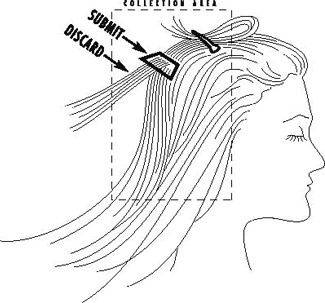
HAIR SAMPLING INSTRUCTIONS
For accurate Hair Mineral Analysis readings, the sampling procedure is very important. Here are the instructions on how to sample your hair:
Step 1: Sampling. Hair should be clean and dry when it is being sampled. The sample should be taken between four and twenty hours after washing. Use a plain shampoo when washing your hair because many shampoos contain EDTA or other chelating agents that remove minerals. A natural shampoo is best. Most shampoos and conditioners do not contain minerals that can contaminate the sample. However, medicated shampoos of concern are Selsun Blue (selenium) and Head and Shoulders (zinc), which should both be avoided. The hair should also be free of all gels, oils, creams, and other products prior to sample collection. Avoid sending dirty, sweaty, or greasy hair.
Step 2: Sampling Location. Hair should be clean and dry when it is being sampled. The sample should be taken between four and twenty hours after washing. Use a plain shampoo when washing your hair because many shampoos contain EDTA or other chelating agents that remove minerals. A natural shampoo is best. Most shampoos and conditioners do not contain minerals that can contaminate the sample. However, medicated shampoos of concern are Selsun Blue (selenium) and Head and Shoulders (zinc), which should both be avoided. The hair should also be free of all gels, oils, creams, and other products prior to sample collection. Avoid sending dirty, sweaty, or greasy hair.

Please do not send facial, chest, underarm, or pubic hair because it is not as accurate. Scalp hair is ideal. If scalp hair is not available, pubic and other body hair should only be used as a last resort. Pubic and other body hair is only recommended for confirmation of elevated toxic metals found in the scalp hair and/or to rule out external contamination of the scalp hair.
Step 3: Equipment Needed. A standard rat-tailed comb and regular stainless steel scissors are all that is basically needed. The scissors must be clean. Stainless steel is better than aluminum. If using plated scissors, make sure the plating is not peeling off, which could contaminate the hair sample. For short hair, thinning shears may be used to keep from disturbing the hair style as much as possible. With long hair, a hair pin or clip may also be useful. If you shave your head, cut the hair with a clean electric razor. Save the clippings in a paper envelope, and then razor cut it again in a week or so, and repeat a few times, until you fill a tablespoon with hair.
Step 4: Cutting a Sample. Comb and lift a section of hair on your head. Either pin or clip the section or hold it up out of the way. Separate a smaller section and cut the hair as close to the scalp as possible. For short hair: 1 ½ inches in length or less – use the entire sample. For long hair: over 1 ½ inches in length, cut off and use 1 inch to 1 ½ inches of the hair from the end that was next to the scalp. Discard the rest. Do NOT send in a sample that is cut from the ends of long hair. AVOID sending hair that is longer than 1.5 inches.
Step 5: Amount of Sample. There should be approximately 125 mgs in the total sample. This should be about one heaping tablespoonful. Once an adequate sample is accumulated, put the hair into an envelope. Make sure to write your name, gender, and shampoo used on the envelope. Do not place hair samples in plastic baggies or aluminum foil. Do not tape or staple the hair sample to the envelope.
Are There Any Special Requirements for Submitting a Hair Sample?
Bleaching / Tints / Permanents / Dyes: The sample of hair to be collected should not be permed, dyed or bleached. If your hair has been bleached, tinted, permed or dyed, wait until sufficient new virgin growth has emerged to allow collection. If you do use a hair dye, it is always best to buy a natural one. Stay away from Youth Hair and Grecian Formula hair dyes because they contain lead, a toxic metal.
Environmental / Occupational Exposure: For those individuals environmentally and/or occupationally exposed to external contaminants, (welding, mining, etc.) special care should be taken to limit exposure between washing of the hair and the collection of the sampled hair.
Water Softeners: Water softeners may affect hair mineral readings. If you have a water softener, you must shampoo your hair two times with unsoftened tap water or reverse osmosis water before sampling.
Swimming Pools: Swimming in pools regularly can affect the mineral hair readings. Stay out of swimming pools and hot tubs due to toxicity.

